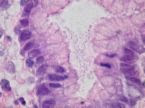 The property of cell membranes or biological membranes that cover the cells all around, is an important deciding factor in permitting or denying entry of molecules to and fro. Any drug or molecule has to have an aqueous phase (water soluble) in order to dissolve in the surrounding water molecules and negotiate further. At the same time, it has to be lipid soluble, to pass through the hydrophobic domain of the cell membrane. Some peculiar instances arise from these effects.
The property of cell membranes or biological membranes that cover the cells all around, is an important deciding factor in permitting or denying entry of molecules to and fro. Any drug or molecule has to have an aqueous phase (water soluble) in order to dissolve in the surrounding water molecules and negotiate further. At the same time, it has to be lipid soluble, to pass through the hydrophobic domain of the cell membrane. Some peculiar instances arise from these effects.Aspirin, a non steroidal anti inflammatory drug (NSAID), is used to treat fever, pain, coagulation disorders and various other ailments. Chemically it is a weak acid, acetyl-salicylic acid, a semi synthetic derivative of salicin, a chemical extracted from the willow bark, which was seen to be of use in curing fever and pain. When aspirin is ingested, it goes inside the stomach where the pH is in the acidic range (pH is low). Aspirin being a weak acid, can not ionize in the acidic pH of the stomach, according to Le Chatelier's principle. Thus, it behaves like a non-polar compound in the gastric lumen. Therefore, it hardly faces any difficulty to enter inside the epithelial cells, as non-polar compounds behave as lipophilic (hydrophobic) compounds. But once inside the cell, they come across an entirely different situation. The pH is high (alkaline) here. Aspirin ionizes as a result. The problem starts. Ionized aspirin now behaves as a polar compound. What a volte face! Being polar, it now can not diffuse back, as it can not cross the lipid barrier in the cell membrane. Aspirin is now trapped inside, to the detriment of the patient, as the likelihood of peptic ulceration increase. This phenomenon is known as 'ion trapping'. Thus, aspirin and other inhibitors of the cyclooxygenase pathway like ibuprofen or acetaminophen (US) [= paracetamol (UK)], plays a very important part in ulcer causation. COX enzymes are in charge of producing chemicals called prostaglandins and other bioactive molecules. Prostaglandins (PG) have a varied role spanning from fever and inflammation to pain. They also ensure the vitality and vascularity of the gastric epithelium, in addition to having an ulcer prevention role in the stomach and duodenum. Hence, pathways interfering with PG synthesis will likely cause gastric ulcers too, along with the desired objective of analgesia or antipyresis.
Another fine example of ion trapping is that of the anti ulcer drug omeprazole. The acidity of the stomach is due to the secretion of hydrogen ions (H+) by the parietal cells (oxyntic cells) of the stomach. This secretion is helped by an energy-driven pump, called the proton pump (H+/K+ ATPase), since H+ ion is same as a proton. Drugs such as omeprazole, pantoprazole, rabeprazole, esomeprazole and other such drugs inhibit this pump; and hence grouped under proton pump inhibitors (PPI).
Omeprazole, for example is a prodrug (has to be converted in the body to be activated). It is alkaline in nature and has to be given in an enteric coated form so that it can not be degraded by the acidity of the stomach. It dissolves in the alkaline environment of the small intestine, and as expected, it does not ionize. By not ionizing, it behaves as lipophilic and gets absorbed across biological membranes; is transported by blood to be secreted in the parietal cells. There, in the apical canaliculus, where the pH is very low (acidic), it dissociates into the active sulfonamide cations and consequently gets trapped (cations are positively charged ions, so named because they are attracted towards the cathode), which then cause disulfide linkages within the H+/K+ ATPase molecular structure to occur. The proton pumps get blocked. Acidity of stomach decreases. Ulcer healing is facilitated. Physics, physiology, chemistry, medicine are all inter related. United we stand.
Last Modified: Mar10,2014
1 comment:
Thank you, this explanation was amazing, just what I was looking for. I also highly appreciate the extra information given here and there,really links it all together in my head :)
Post a Comment